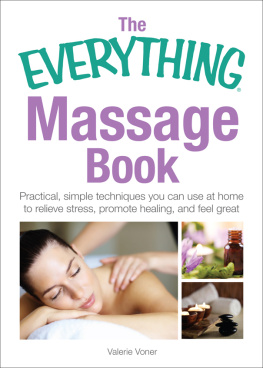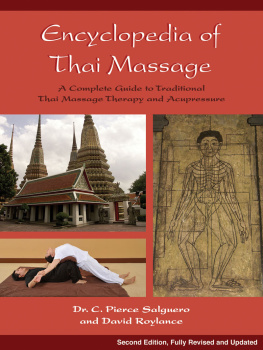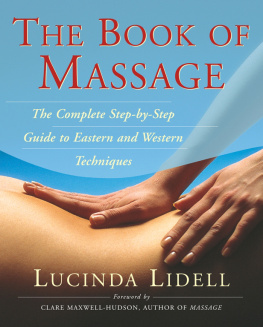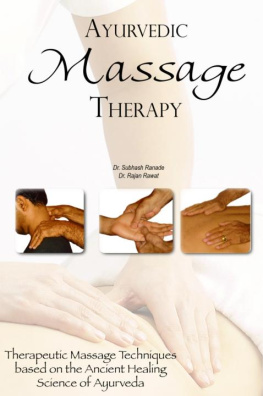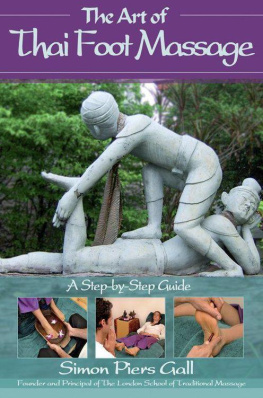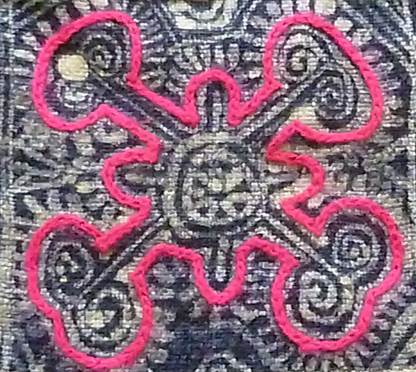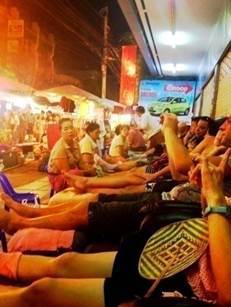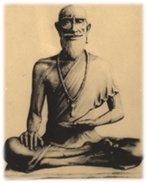THAI FOOT & HAND MASSAGE
Elefteria Mantzorou
Contents
Although the author and publisher have made every effort to ensure that the information in this book was correct, the author does not assume and hereby disclaims any liability to any party for any loss, damage, or disruption caused by errors or omissions, whether such errors or omissions result from negligence, accident, or any other cause. This book is not intended as a substitute for the medical advice of physicians. The reader should regularly consult a physician in matters relating to his/her health and particularly with respect to any symptoms that may require diagnosis or medical attention.
Copyright 2013, Eleftheria Mantzorou
All rights reserved. No part of this publication may be reproduced, distributed, or transmitted in any form or by any means, including photocopying, recording, or other electronic or mechanical methods, without the prior written permission of the publisher, except in the case of brief quotations embodied in critical reviews and certain other noncommercial uses permitted by copyright law.
Authors email address:
Authors website: jointheflow.weebly.com
CHAPTER ONE
INTRODUCTION
INTRODUCTION
Thai Foot Massage is a traditional treatment, and it is becoming increasingly popular worldwide. In India and Southeastern Asia it is practiced since thousands of years, with small variations from area to area. In Thailand, it is the most popular treatment. Yep, it is more popular even than Thai Massage! This is mainly due to the fact that it is easier to be practiced, as it has less space and facility requirements in comparison to Thai Massage. Also, Thai Foot Massage is easier to be learned, because it focuses on the foot and the cnemis. Moreover, a Thai Foot Massage session is cheaper than a Thai Massage session.
Thai Foot Massage is part of Traditional Thai Medicine (TTM), which constitutes an autonomous healing system. TTM also includes dietology, herbal medicine, exercise, meditation, and of course Thai Massage. In Thailand, Thai Foot Massage is practiced in all levels of society, as is the case with Thai Massage. Thus, it is practiced everywhere, from the most luxurious spas to the most crowded vegetable markets. I personally love seeing this row of Thai people receiving Thai Foot Massage on a plastic chair in a vegetable market, or even on a blanket on a sidewalk. Of course, Thai Foot Massage is also offered in modest massage shops, as well as in some Buddhist temples.
Thai Foot Massage on the street, in a Thai night market,
(Off the Beaten Path Travel, otptravel.com)
Wait a minute! Did you just say that massage is practiced in a church?? Yep, that would be quite weird for the Western society. However, Thais believe that massage is a sacred art, because it promotes inner peace. Furthermore, it is believed that the founding father of Thai medicine is a traditional healer named Jivaka, who was the Buddhas personal physician. For this reason, many Thai (and some Western) therapists address a small prayer to Jivaka before the beginning of each massage session. This is optional, and can be omitted if it is incompatible with ones beliefs.
JIVAKAS PRAYER
Om Namo Shivago Sirasa Ahang
Karuniko Sapatasanang O-Satha
Tipa Mantang Paphaso Suriya-Jantang
Komarapato Paga-Sesi Wantami
Bantito Sumetaso A-Lokha Sumana-Homi
We invite the spirit of our Founder, the Father Doctor Jivaka, who inspires us though his saintly life. Please grant us the knowledge of nature, which is the ultimate medicine of the universe. In the name of this mantra, we seek your help, and pray that through our bodies you will bring wholeness and health to the body of our client.
Jivaka, the founding Father of Thai Massage
About me
I was born in Athens, Greece. My first contact with healing was in a wildlife sanctuary in the island of Paros, Greece, where I treated mainly wild birds. It was there that I met a Buddhist Lama, whose teachings changed my life.
This was followed by many trips in India and Thailand, where I practiced yoga and meditation. In Thailand, I studied in Old Medicine Hospital and Lek Chaiya, in Chiang Mai. I was trained in traditional Thai Massage, Thai Foot Massage and Herbal Packs Massage.
I have also attended the typical 120 hs course in western anatomy and pathology, and I hold a degree in medical translation. I am trained in various forms of bodywork, like Hot Stones Massage and Deep Tissue Massage. I have been teaching massage, herbal medicine and aromatherapy since 2004. This is my second book on Thai Massage.
I am the director of the FLOW Wellness & Training centre, where I teach courses on Thai Massage, Thai Foot Massage and herbal medicine.
My website is: jointheflow.weebly.com
Love and light,
Elefteria
HOW THAI FOOT MASSAGE WORKS
Foot massage brings immediate relief and relaxation. This may be due to the fact that our feet have many nerve endings. Thus, the feeling of serenity and wellness in transferred throughout the body, via these nerve endings. This could be a scientific explanation for the benefits of foot massage, which also has an anatomical basis.
However, there is another explanation about this wellness feeling that foot massage brings, which is not necessarily related to anatomical structures. We are talking about an Oriental approach. Thus, according to Thai medicine, the foot has some pressure points, and massage on these points restores the bodys inner balance. In Western terms, that means that massage may promote homeostasis. This view may not be compatible with the principles of Western physiology. However, it is a fact that Thai Foot Massage does bring relief and wellness. And a person who experiences this wellness is not going to bother if the Thai pressure points or the Thai meridians do not have a concrete anatomical existence. In any case, the feeling of wellness does have a clinical value. Period. One day the science of neuroimmunology may discover mechanisms of the human body that are unknown to us right now.
THAI FOOT MASSAGE AND REFLEXOLOGY
Thai Foot Massage is more ancient than reflexology (an approach that was presented in 1913, which holds that parts of the body correspond to reflex areas or points on the feet). Of course, the antiquity of a system is not related to its therapeutic value. This is mentioned simply as an objective fact.
During a Thai Foot Massage, the therapist works on pressure points. However, these points are not identical to the reflexology points, nor do they correspond to specific organs or glands of the human body. Thus, these two approaches have outstanding differences. Consequently, a Thai Foot Massage therapist cannot apply reflexology protocols that aim to the treatment of specific diseases. The goal of Thai Foot Massage is the induction of wellness and calmness, the prevention of diseases and the achievement of inner balance and harmony. And these goals are indeed achieved! Of course, the experienced therapist who possesses adequate knowledge of the human anatomy and pathology can help a patient who suffers from a myoskeletal disorder.


